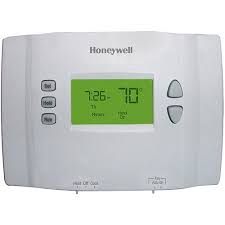Honeywell can actually trace its roots back to 1885 when Albert Butz invented a damper flapper, the first thermostat for coal furnaces, for the Minneapolis Heat Regulator Company.
In 1906, Mark C. Honeywell founded the Honeywell Heating Specialty Company in Wabash, Indiana. In 1927, Honeywell merged with Minneapolis Heat Regulator. Mark Honeywell was made President and W.R. Sweatt was made chairman.
W.R. Sweatt and his son Harold lead Honeywell for the next 75 years, turning a small idea (the thermostat) into a thriving business. 
In 1943, James Binger joined the company and became President in 1961. Binger revamped the company’s sale approach and focused on profit margin instead of total revenues.
Starting in the 1970’s, the company decided to focus on process controls. The company merged some of their systems with GE‘s information systems and later acquired GE’s processing systems.
In 1986, the company took on a new direction by acquiring Sperry Aerospace while discontinuing their computer programs with the rise of the IBM personal computer.
In 1987, the company began offering a home security system and later, Smart Home control systems. 
In 1999, Honeywell merged with AlliedSignal. Although AlliedSignal was the bigger company, Honeywell was the more recognizable name. In October of 2015, the “new” Honeywell company moved their headquarters to Morris Plains, New Jersey. The new 475,000-square-foot building on 40 plus acres features state-of-the-art technology, as well as greater energy efficiency than Honeywell’s old Morristown headquarters, which was underutilized, outdated and costly, according to then CEO Dave Cote.
The company is publicly traded on the NYSE under the ticker symbol: HON. Honeywell had annual revenue of $40.5 billion in 2017 and has more than 131,000 employees worldwide, with approximately 58,000 of those being in the US.
Today, Honeywell produces many consumer and commercial products and also provides engineering and aerospace services. Honeywell is a Fortune 100 company. 
Honeywell can actually trace its roots back to 1885 when Albert Butz invented a damper flapper, the first thermostat for coal furnaces, for the Minneapolis Heat Regulator Company.
History
In 1906, Mark C. Honeywell founded the Honeywell Heating Specialty Company in Wabash, Indiana. In 1927, Honeywell merged with Minneapolis Heat Regulator. Mark Honeywell was made President and W.R. Sweatt was made chairman.
W.R. Sweatt and his son Harold lead Honeywell for the next 75 years, turning a small idea (the thermostat) into a thriving business. 
In 1943, James Binger joined the company and became President in 1961. Binger revamped the company’s sale approach and focused on profit margin instead of total revenues.
Starting in the 1970’s, the company decided to focus on process controls. The company merged some of their systems with GE‘s information systems and later acquired GE’s processing systems.
In 1986, the company took on a new direction by acquiring Sperry Aerospace while discontinuing their computer programs with the rise of the IBM personal computer.
In 1987, the company began offering a home security system and later, Smart Home control systems. 
In 1999, Honeywell merged with AlliedSignal. Although AlliedSignal was the bigger company, Honeywell was the more recognizable name. In October of 2015, the “new” Honeywell company moved their headquarters to Morris Plains, New Jersey. The new 475,000-square-foot building on 40 plus acres features state-of-the-art technology, as well as greater energy efficiency than Honeywell’s old Morristown headquarters, which was underutilized, outdated and costly, according to then CEO Dave Cote.
The company is publicly traded on the NYSE under the ticker symbol: HON. Honeywell had annual revenue of $40.5 billion in 2017 and has more than 131,000 employees worldwide, with approximately 58,000 of those being in the US.
Today, Honeywell produces many consumer and commercial products and also provides engineering and aerospace services. Honeywell is a Fortune 100 company. 
